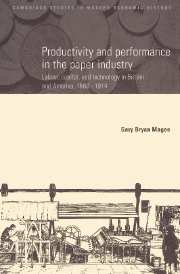 Productivity and Performance in the Paper Industry
Productivity and Performance in the Paper Industry Book contents
- Frontmatter
- Contents
- List of figures
- List of tables
- Acknowledgements
- List of abbreviations
- Introduction
- 1 Background
- 2 Technological change
- 3 Performance
- 4 Rags, esparto, and wood: entrepreneurship and the choice of raw materials
- 5 The Anglo-American labour productivity gap
- 6 Unions and manning practices in Britain and America
- 7 Raw materials, women, and labour-saving machinery: the Anglo-American gap, 1860–1890
- 8 Technological divergence: the Anglo-American gap, 1890–1913
- 9 Free trade and paper
- Conclusion
- Bibliography
- Index
8 - Technological divergence: the Anglo-American gap, 1890–1913
Published online by Cambridge University Press: 16 March 2010
- Frontmatter
- Contents
- List of figures
- List of tables
- Acknowledgements
- List of abbreviations
- Introduction
- 1 Background
- 2 Technological change
- 3 Performance
- 4 Rags, esparto, and wood: entrepreneurship and the choice of raw materials
- 5 The Anglo-American labour productivity gap
- 6 Unions and manning practices in Britain and America
- 7 Raw materials, women, and labour-saving machinery: the Anglo-American gap, 1860–1890
- 8 Technological divergence: the Anglo-American gap, 1890–1913
- 9 Free trade and paper
- Conclusion
- Bibliography
- Index
Summary
In chapter 7 it was argued that, up until 1890, the differential in the level of labour productivity experienced by Britain and the United States since the mid-century could primarily be attributed to the effects on the employment of labour within the mill, that the raw materials and the amount of labour-saving machinery used in each nation had had. From 1890, however, it becomes more difficult to explain the persistence of the productivity gap purely in terms of factors that influenced employment practices. As we saw from the data on machine speeds and capacities, as well as total productivity, given in chapters 3 and 5, it is from this date that a technological lead starts to appear in the United States. But if America was pulling ahead of the British technologically, the question must be asked why this was possible?
Differences in the technological paths adopted by each nation may provide an explanation, especially since in earlier years the American industry had made use of different types of machinery. This notwithstanding, however, the fact remains that the basic technique for making paper in the last half of the nineteenth century was for all intents and purposes the same in these countries. Moreover, even if we assume this not to be the case, it was the Cylinder machine – that was slightly more popular in the States – and not the Fourdrinier that had less potential for improvement and speeding up.
- Type
- Chapter
- Information
- Productivity and Performance in the Paper IndustryLabour, Capital and Technology in Britain and America, 1860–1914, pp. 196 - 239Publisher: Cambridge University PressPrint publication year: 1997


